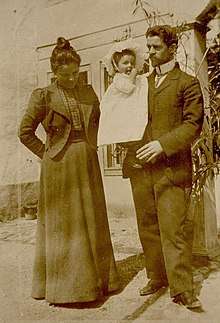Grigor Cilka
Grigor M. Cilka (1875-1919) was an Albanian Protestant reverend and missionary.[1][2] In the height of the Albanian National Awakening he became a teacher at the first Albanian school for girls in Korçë.[3][4]
Grigor Cilka | |
|---|---|
 Grigor Cilka with wife Katerina Cilka and daughter Eleni | |
| Born | 1875 |
| Died | 1919 |
| Occupation | reverend, missionary, teacher |
| Movement | Albanian National Awakening |
Life
Grigor Cilka was born in 1875 in Vithkuq. The family later moved to Monastir.[3] He was educated at missionary schools in Monastir, and later Samokov.[1] Cilka was a convert from Orthodox Christianity to Protestant Christianity.[5] He went to New York City, United States to finish his education at the Union Theological Seminary.[1] During his stay in the US, Cilka in 1899 married Katerina Cilka, a Bulgarian nurse and Protestant from Bansko.[1][6] In the summer following their marriage, they returned, settled in Korçë and dedicated their efforts toward missionary work, teaching and humanitarian activities in surrounding villages.[1][6][7][8] Cilka founded a Protestant parish in Korçë.[9] After studying theology, Cilka became a member of Korçë-based organisations that sought the creation of an Albanian state independent of the Ottoman Empire.[10][11] In the late nineteenth century debate over choosing an Albanian alphabet, Cilka was a supporter of the Frashëri alphabet.[2] Together with his wife Katerina, Cilka served as teacher at the first Albanian school for girls in Korçë.[3][4]
In 1901, Katerina, pregnant for 6 months, embarked on a regional tour with, and at the invitation of her friend American Protestant missionary Ellen Maria Stone.[1][6] Both were kidnapped by Internal Macedonian Revolutionary Organization (IMRO) members who ransomed them for money[1][6] in what become known internationally as the Miss Stone Affair. Ottoman authorities suspected Protestants of involvement and for a short time, Cilka was arrested on orders by the vali (governor) of Salonika on unfounded charges of being complicit in the kidnapping.[12][13][14] The Cilkas returned to Korçë and authorities from the Ottoman state continued to suspect the couple of involvement in the event.[15] The couple had a daughter named Eleni.[15] During the IMRO Ilinden Uprising against the Ottoman Empire (1903), to prevent additional persecution by the Ottomans, the Austro-Hungarian consul assisted the couple to temporarily flee the region.[15]
In 1908, Cilka was a delegate to the Congress of Manastir, an academic conference with the goal of standardizing the Albanian alphabet. He was active in contemporary public discussions over culture and education in Ottoman territories with Albanian populations, and supported in various newspapers the usage of Latin script to write Albanian.[10] To boost education and intellectual thought among Albanian people, Cilka promoted various literary works known around the world.[3] Cilka served as director of the girls' school, later he was imprisoned by Ottoman authorities and the educational institution closed shortly thereafter in February 1904.[16] In 1906, an Albanian guerilla band assassinated Greek bishop Photios and Ottoman authorities unable to arrest the perpetrators, had Cilka and other Korçë Albanian notables involved in the national movement imprisoned, but released soon after.[17] Cilka in 1906 was involved in the establishment of groups geared toward nationalist aims.[18] After the declaration of independence, Cilka moved to Bulgaria where he died in 1919 from the Spanish flu.[10]
See also
- Mësonjëtorja
- Albanian Alphabet
- Education in Albania
References
- Walton, Andrea. Women and Philanthropy in Education. Indiana University Press. p. 192. ISBN 9780253111319.CS1 maint: ref=harv (link)
- Clayer 2007, p. 618.
- Myzyri, Hysni (2004). Pandeli J. Evangjeli, 1859 - 1949: atdhetar dhe burrë shteti i shquar. Albpaper. p. 132. ISBN 9994360175.CS1 maint: ref=harv (link)
- Skendi 1967, pp. 136, 156.
- Clayer, Nathalie (2007). Aux origines du nationalisme albanais: La naissance d’une nation majoritairement musulmane en Europe [The origins of Albanian nationalism: The birth of a predominantly Muslim nation in Europe]. Paris: Karthala. pp. 315, 618. ISBN 9782845868168.CS1 maint: ref=harv (link)
- Thanailaki, Polly (2018). Gender Inequalities in Rural European Communities During 19th and Early 20th Century: A Historical Perspective. Springer. p. 81. ISBN 9783319752358.CS1 maint: ref=harv (link)
- Daniel 1970, p. 134.
- Sherman 1980, p. 25.
- Sherman 1980, p. 27.
- Ermenji, Abas (1996). Vendi që zë Skënderbeu në historinë e Shqipërisë. Çabej. p. 237.CS1 maint: ref=harv (link)
- Daniel 1970, p. 142.
- Perry, Duncan M. (1988). The Politics of Terror: The Macedonian Liberation Movements, 1893-1903. Duke University Press. p. 104. ISBN 9780822308133.CS1 maint: ref=harv (link)
- Daniel, Robert L. (1970). American philanthropy in the Near East, 1820-1960. Ohio University Press. p. 135. ISBN 9780821400630.CS1 maint: ref=harv (link)
- Sherman 1980, p. 89.
- Sherman, Laura Beth (1980). Fires on the Mountain: The Macedonian Revolutionary Movement and the Kidnapping of Ellen Stone. East European Monographs. p. 98. ISBN 9780914710554.CS1 maint: ref=harv (link)
- Skendi 1967, p. 137.
- Skendi 1967, p. 210.
- Skendi, Stavro (1967). The Albanian National Awakening. Princeton: Princeton University Press. p. 156. ISBN 9781400847761.CS1 maint: ref=harv (link)
Further reading
- Carpenter, Teresa (2004). The Miss Stone Affair: America's First Modern Hostage Crisis. Simon and Schuster. ISBN 9780743258050.
- Cochran, Richard M. (2014). Katerina Stephanova Tsilka (PDF). Institute for Albanian & Protestant Studies.